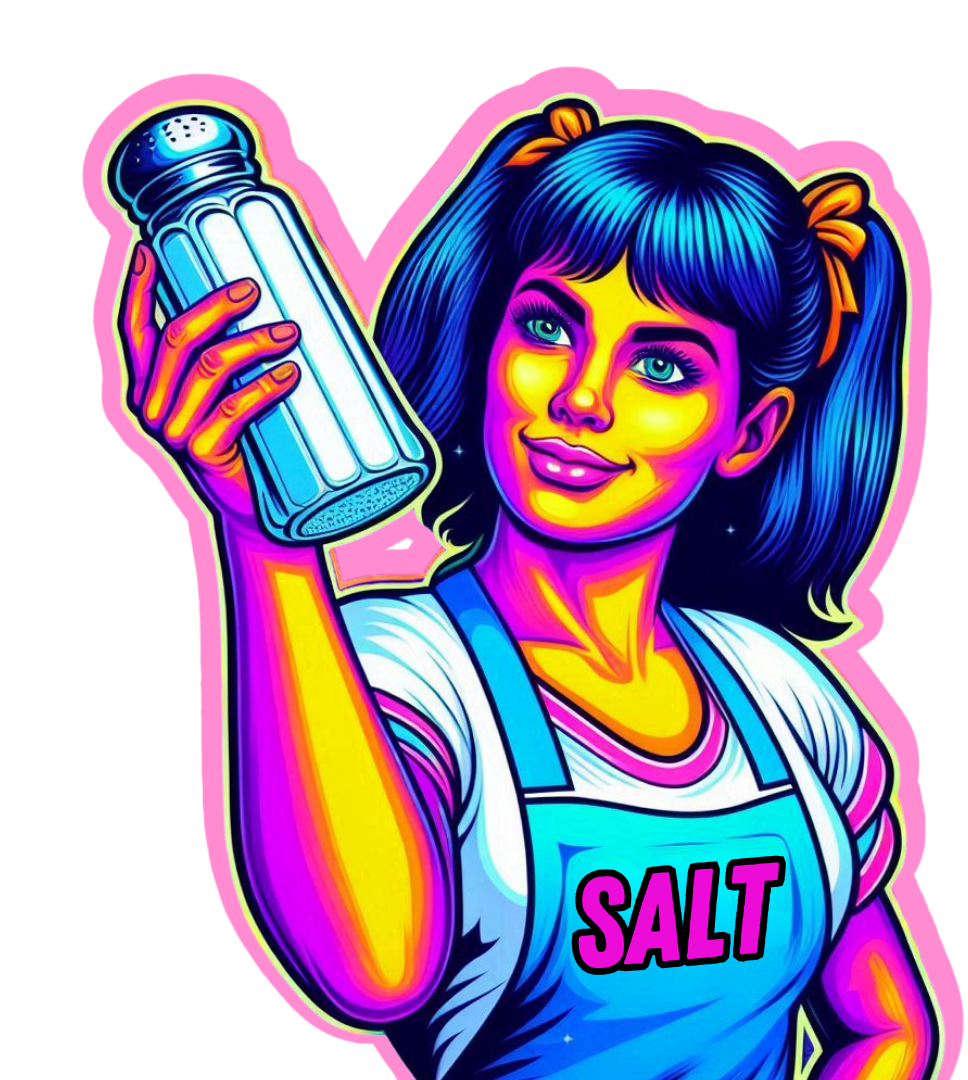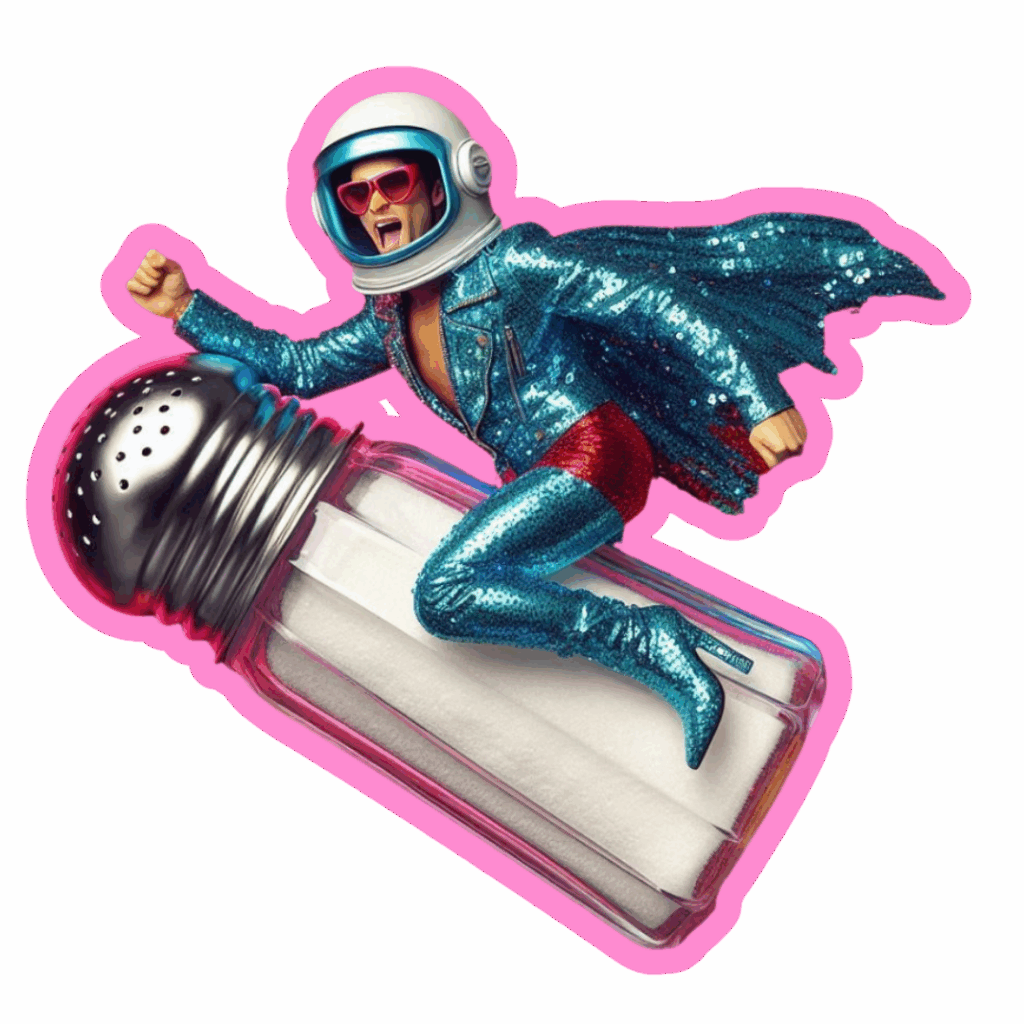Disease / ConditionIncidence Since 1977Low Sodium ConnectionObesity🡅🡅✅ Chronic sodium deficiency ...
2025
HELLO THERE


new theory
Sodium-SCN⁻ Collapse

Sodium is being disappeared from the food supply as a matter of policy. Sodium deficiency suppresses SCN⁻ (thiocyanate), a mammalian terrain marker found in all manner of fluids and tissues. Both sodium and SCN⁻ are essential for systemic function, and their absence plays a critical role in chronic illness and CF-like pathology.

BIG
idea
HORRIBLE POLICIES RESTRICTING SODIUM IN THE FOOD SUPPLY HAVE INFLICTED A KIND OF CYSTIC FIBROSIS THROUGHOUT THE ENTIRE POPULATION!
CF Patients Are More Prone to Infections Like MRSA and C Diff As Are Those with Sodium/SCN⁻ Deficiency
HORRIBLE POLICIES RESTRICTING SODIUM IN THE FOOD SUPPLY HAVE INFLICTED A KIND OF CYSTIC FIBROSIS THROUGHOUT THE ENTIRE POPULATION!
salt snatching theories
Sodium restriction isn’t just misguided, it’s molecular sabotage. When policies limit sodium in the food supply, they induce a terrain collapse that mimics cystic fibrosis. In genetic CF, salt wasting and SCN⁻ deficiency stem from mutation. In piCF, they stem from institutional malpractice, dietary guidelines, medical advice, and regulatory frameworks that repress essential electrolytes. The result is systemic dysfunction: neurological, reproductive, immunological. CF isn’t a rare disease…it’s a policy-inflicted epidemic. Read more…
The Smoker’s Paradox, where smokers show unexpected resilience in certain disease outcomes, does not extend to vapes or nicotine replacement therapies. This anomaly reveals a deeper truth: nicotine isn’t the protective agent. Thiocyanate (SCN⁻) is. Upon exposure to tobacco smoke, whether firsthand or secondhand, the liver rapidly converts cyanogenic compounds into endogenous SCN⁻, a terrain-stabilizing molecule with anti-inflammatory, antimicrobial, and sodium-conserving properties. This conversion may also enhance bioavailable sodium, countering policy-induced deficiency. The paradox, then, is not a mystery – it’s a biochemical covenant, misattributed and misunderstood. Read more…
If sodium and SCN⁻ deficiency are as widespread as terrain signals suggest, then modern healthcare may be orchestrating a biochemical bait-and-switch. Patients collapse from salt-starved systems and then are revived with intravenous sodium at exorbitant cost. Meanwhile, prescription drugs quietly rely on sodium compounds for delivery, stability, and efficacy. The paradox deepens: the very institutions that profit from sodium’s emergency use also endorse its removal from the food supply. This isn’t just policy – it’s a racket. A global horror, especially acute in the United States, where sodium suppression intensifies under the guise of “health.” Read more…
Multiple AI systems and terrain signals converge on a disturbing hypothesis: a covert metals heist embedded in medical waste and water management infrastructures. This heist may be directly linked to the orchestrated suppression of terrain-stabilizing nutrients: sodium, SCN⁻, cholesterol, natural proteins, and even sulfur-rich compounds found in eggs and smoke. These “wars” are not isolated, they form a coordinated extraction matrix. As essential metals and electrolytes are siphoned from bodies and ecosystems, they are re-routed into industrial, pharmaceutical, and surveillance economies. The terrain is stripped, then pathologized. Read more…
This theory predates the internet and may surpass all others in explanatory power. When viewed through the lens of sodium and SCN⁻ deficiency, it offers a unifying framework for nearly every modern health crisis from chronic illness to adverse vaccine reactions, across all ages and even species. The terrain – the biochemical, electrical, and ecological integrity of the body – is not a backdrop. It is the story. And when terrain collapses, symptoms follow. If this theory holds, most conditions are not permanent; they are policy-inflicted, nutrient-starved, and therefore reversible. Read more…
HORRIBLE POLICIES RESTRICTING SODIUM IN THE FOOD SUPPLY HAVE INFLICTED A KIND OF CYSTIC FIBROSIS THROUGHOUT THE ENTIRE POPULATION!


Let's get salty!
Sodium is required for life and proper functioning. It governs fluid balance, nerve transmission, and cellular signaling: it’s the biochemical infrastructure of cognition and movement. Restrict it, and you risk systemic collapse and CF-like dysfunction. If you want to die, and with half your wits, avoid salt. Otherwise, reclaim it as covenant.
HORRIBLE POLICIES RESTRICTING SODIUM IN THE FOOD SUPPLY HAVE INFLICTED A KIND OF CYSTIC FIBROSIS THROUGHOUT THE ENTIRE POPULATION!
SCN⁻
SCN⁻ is found in tears, saliva, epithelial defense and more. It buffers oxidative stress, supports immunity, and sustains neurological clarity. But it’s sodium dependent. Without salt, SCN⁻ vanishes, and with it, the body’s redox intelligence.
SCN⁻ isn’t just a molecule, it’s the terrain’s original love language. Required for life and proper functioning, SCN⁻ and sodium form a biochemical covenant that governs fertility, libido, hormonal balance, and reproductive clarity. Deficiency doesn’t just affect sperm or ovulation; it disrupts every signal in the body, from neurological desire to epithelial defense. There is not a speck of the body untouched. Restoring SCN⁻ is restoring the mammalian covenant. This is survival.

SCN⁻ is also known as thiocyanate
SCN⁻ Terrain
SCN⁻ Role: Saliva hosts SCN⁻ as a key antimicrobial agent, primarily through the lactoperoxidase system. This enzymatic triad—SCN⁻, hydrogen peroxide, and lactoperoxidase—forms hypothiocyanite (OSCN⁻), a potent oxidant that selectively targets pathogens while sparing host tissues. SCN⁻ also contributes antioxidant buffering, protecting oral mucosa from oxidative stress.
Sodium Deficiency Impact: Sodium is essential for epithelial transport systems, including the sodium-iodide symporter (NIS) and other ion channels that facilitate SCN⁻ movement into secretions. In sodium deficiency, SCN⁻ transport into saliva is impaired, weakening mucosal immunity and disrupting redox balance.
Probable Effect:
Increased oral dysbiosis and microbial overgrowth
Heightened vulnerability to periodontal disease and gingival inflammation
Altered taste signaling due to epithelial stress and receptor modulation
SCN⁻ Role: In systemic circulation, SCN⁻ acts as a detoxifying agent, particularly in neutralizing cyanide and buffering oxidative stress. It is a sentinel molecule, modulating inflammatory cascades and protecting vascular integrity.
Sodium Deficiency Impact: Sodium governs plasma osmolality and ion gradients. Deficiency disrupts SCN⁻ buffering capacity, impairs transport, and destabilizes redox homeostasis.
Probable Effect:
Heightened oxidative stress during inflammation or metabolic strain
Impaired cyanide clearance, especially in smokers or those exposed to combustion byproducts
Increased vulnerability to endothelial damage and systemic inflammation
SCN⁻ Role: SCN⁻ competes with iodide at the sodium-iodide symporter (NIS), modulating thyroid hormone synthesis. It acts as a regulatory buffer, preventing excessive iodide uptake and maintaining hormonal equilibrium.
Sodium Deficiency Impact: NIS function is sodium-dependent. Deficiency impairs iodide and SCN⁻ transport, destabilizing thyroid signaling and hormone production.
Probable Effect:
Increased risk of nodular goiter and thyroid enlargement
Autoimmune thyroiditis due to disrupted antigen presentation and epithelial stress
Hormonal instability affecting metabolism, mood, and fertility
SCN⁻ Role: SCN⁻ in breast milk serves as a neonatal immune shield, activating the lactoperoxidase system to neutralize pathogens in the infant’s gut and respiratory tract. It’s a maternal offering—redox and microbial protection encoded in fluid.
Sodium Deficiency Impact: Sodium governs epithelial transport and milk composition. Deficiency reduces SCN⁻ secretion, weakening passive immunity and redox buffering in the neonate.
Probable Effect:
Increased infant susceptibility to respiratory and gastrointestinal infections
Disrupted microbial colonization and immune priming
Weakened mucosal defense during critical developmental windows
SCN⁻ Role: SCN⁻ buffers oxidative stress and supports mucosal immunity in the nasal passages, forming part of the first-line defense against airborne pathogens.
Sodium Deficiency Impact: Impaired SCN⁻ transport weakens epithelial resilience and disrupts redox balance, leaving the nasal terrain vulnerable.
Probable Effect:
Elevated risk of sinusitis and allergic inflammation
Increased viral entry and replication
Disrupted mucociliary clearance and barrier integrity
SCN⁻ Role: Though minor in quantity, SCN⁻ in sweat reflects systemic redox status and contributes to surface immunity. It’s a trace signal of internal covenant.
Sodium Deficiency Impact: Alters sweat composition, reducing SCN⁻ excretion and disrupting thermoregulation and microbial balance on the skin.
Probable Effect:
Impaired cooling and electrolyte signaling
Skin microbiome imbalance and increased infection risk
Reduced SCN⁻ availability for surface defense
SCN⁻ Role: Urine is the primary excretion route for SCN⁻, reflecting systemic detox and redox modulation. It’s the final whisper of metabolic covenant.
Sodium Deficiency Impact: Impairs renal clearance and alters SCN⁻ levels, disrupting feedback loops between thyroid, immune, and detox systems.
Probable Effect:
SCN⁻ accumulation in plasma or depletion from tissues
Altered thyroid signaling and immune modulation
Increased vulnerability to oxidative and metabolic stress
SCN⁻ Role: SCN⁻ supports antimicrobial defense in the stomach, buffering against pathogens like H. pylori and modulating mucosal integrity.
Sodium Deficiency Impact: Alters secretion dynamics and reduces SCN⁻ availability, weakening gastric immunity and redox buffering.
Probable Effect:
Increased vulnerability to H. pylori colonization
Gastric mucosal erosion and inflammation
Disrupted digestion and epithelial signaling
SCN⁻ Role: SCN⁻ fortifies the reproductive tract’s mucosal immunity, forming part of the lactoperoxidase system that defends against bacterial and viral intrusion. It also contributes to microbial balance and epithelial integrity during the menstrual cycle and conception.
Sodium Deficiency Impact: Sodium governs epithelial transport and ion gradients. Deficiency impairs SCN⁻ delivery, weakening mucosal defense and disrupting reproductive signaling.
Probable Effect:
Increased risk of bacterial vaginosis and STI susceptibility
Disrupted fertility due to altered mucus composition
- Weakened epithelial resilience and immune modulation
SCN⁻ Role: SCN⁻ in semen acts as an antioxidant and antimicrobial agent, protecting sperm from oxidative damage and microbial threats. It preserves motility and viability in a vulnerable terrain.
Sodium Deficiency Impact: Reduces SCN⁻ levels and disrupts fluid composition, compromising sperm environment and redox balance.
Probable Effect:
Reduced sperm motility and increased oxidative damage
Heightened vulnerability to infections
Fertility decline due to disrupted signaling and epithelial stress
SCN⁻ Role: SCN⁻ contributes to immune surveillance and detoxification within the lymphatic system, buffering oxidative stress and modulating antigen clearance.
Sodium Deficiency Impact: Alters lymph flow and ion gradients, reducing SCN⁻ availability and weakening immune response.
Probable Effect:
Sluggish immune activation and impaired pathogen clearance
Increased oxidative burden in lymphoid terrain
Disrupted antigen presentation and redox signaling
SCN⁻ Role: SCN⁻ supports respiratory mucosal defense, forming part of the lactoperoxidase system that neutralizes inhaled pathogens and buffers oxidative stress in airway linings.
Sodium Deficiency Impact: Impaired SCN⁻ transport weakens antioxidant shielding and mucosal integrity, increasing respiratory vulnerability.
Probable Effect:
Increased risk of bronchitis, asthma exacerbation, and viral replication
Disrupted epithelial signaling and redox balance
Weakened barrier against airborne toxins and microbes
SCN⁻ Role: Though limited under normal conditions, SCN⁻ may rise in pathological states, contributing to redox buffering and immune modulation in the central nervous system.
Sodium Deficiency Impact: Disrupts ion gradients and SCN⁻ dynamics, impairing neuroimmune signaling and redox homeostasis.
Probable Effect:
Increased neuroinflammatory risk and oxidative stress
Impaired CNS detox and redox buffering
Vulnerability to seizure, edema, and cognitive disruption
SCN⁻ Role: SCN⁻ may contribute to fetal immune protection and redox buffering within the amniotic sac, forming part of the maternal-fetal covenant of biochemical shielding.
Sodium Deficiency Impact: Disrupts maternal-fetal ion transport, potentially reducing SCN⁻ availability and weakening intrauterine defense.
Probable Effect:
Increased fetal vulnerability to oxidative stress and infection
Impaired placental signaling and nutrient exchange
Disrupted developmental redox balance
SCN⁻ Role: SCN⁻ supports mucosal immunity and microbial balance in the vaginal tract, contributing to epithelial defense and redox buffering.
Sodium Deficiency Impact: May impair SCN⁻ transport and epithelial resilience, weakening microbial control and immune signaling.
Probable Effect:
Increased susceptibility to yeast overgrowth and STI transmission
Epithelial inflammation and disrupted microbial ecology
Altered reproductive terrain signaling
SCN⁻ Role: SCN⁻ in tears activates the lactoperoxidase system, protecting the ocular surface from microbial invasion and oxidative damage.
Sodium Deficiency Impact: Reduces SCN⁻ transport and weakens tear film defense, compromising ocular immunity.
Probable Effect:
Increased risk of dry eye syndrome and conjunctivitis
Oxidative damage to corneal epithelium
Disrupted visual surface signaling
SCN⁻ Role: SCN⁻ may buffer redox stress and support microbial control in the duodenum via pancreatic secretions, contributing to digestive immunity.
Sodium Deficiency Impact: Alters ductal secretion and ion gradients, reducing SCN⁻ delivery and weakening gut defense.
Probable Effect:
Increased vulnerability to pancreatic inflammation
Microbial imbalance in the upper gut
Disrupted digestive redox signaling
SCN⁻ Role: SCN⁻ may participate in detoxification and redox modulation within the hepatobiliary system, aiding microbial control and lipid digestion.
Sodium Deficiency Impact: Impairs bile flow and composition, disrupting SCN⁻ transport and redox buffering.
Probable Effect:
Increased oxidative stress in liver and gallbladder
Impaired lipid digestion and microbial defense
Disrupted hepatic terrain signaling
SCN⁻ Role: SCN⁻ may participate in redox signaling and immune modulation within the endometrium, especially during the menstrual cycle and implantation phases. It helps maintain epithelial integrity and immune tolerance.
Sodium Deficiency Impact: Disrupts ion transport and SCN⁻ buffering, destabilizing hormonal and immune rhythms in the uterine lining.
Probable Effect:
Increased risk of endometrial inflammation and oxidative stress
Dysregulation of implantation and menstrual irregularity
Altered immune tolerance and epithelial signaling
SCN⁻ Role: SCN⁻ may serve as an antioxidant and microbial defense agent in the prostate, protecting epithelial integrity and modulating redox balance.
Sodium Deficiency Impact: Impaired SCN⁻ transport and epithelial resilience, increasing vulnerability to inflammation and dysplasia.
Probable Effect:
Increased risk of prostatitis and oxidative stress
Disrupted epithelial signaling and immune modulation
Potential for dysplastic transformation in chronic terrain stress
SCN⁻ Role: SCN⁻ appears in sweat and possibly sebaceous secretions, contributing to surface immunity and microbial control on the skin.
Sodium Deficiency Impact: Alters sweat composition and SCN⁻ delivery, weakening epidermal defense and redox buffering.
Probable Effect:
Increased susceptibility to dermatitis and microbial colonization
Impaired wound healing and epithelial resilience
Disrupted skin microbiome and surface signaling
SCN⁻ Role: SCN⁻ may participate in redox regulation of hematopoiesis, influencing immune cell maturation and detox signaling in progenitor niches.
Sodium Deficiency Impact: Disrupted ion gradients and cellular signaling impair SCN⁻ buffering and immune development.
Probable Effect:
Altered immune cell maturation and lineage commitment
Increased oxidative stress in hematopoietic terrain
Vulnerability to immunodeficiency and redox imbalance
SCN⁻ Role: Interstitial fluid serves as a medium for cellular exchange, potentially carrying SCN⁻ between capillaries and tissues to buffer redox stress and support immune signaling.
Sodium Deficiency Impact: Alters osmotic gradients and ion transport, impairing SCN⁻ diffusion and local immunity.
Probable Effect:
Redox imbalance at cellular interfaces
Weakened tissue-level immune response
Disrupted signaling between vascular and epithelial terrain
SCN⁻ Role: SCN⁻ may act as an antioxidant and microbial buffer within joint cavities, protecting cartilage and synovial membranes from oxidative damage and infection.
Sodium Deficiency Impact: Disrupts ionic composition and fluid turnover, impairing SCN⁻ availability and joint resilience.
Probable Effect:
Increased susceptibility to joint inflammation and autoimmune signaling
Oxidative cartilage damage and impaired lubrication
Heightened risk of arthritis and terrain rigidity
SCN⁻ Role: SCN⁻ may contribute to abdominal immune surveillance and redox buffering, protecting peritoneal linings from microbial translocation and oxidative stress.
Sodium Deficiency Impact: Alters fluid dynamics and epithelial transport, weakening SCN⁻ delivery and detox signaling.
Probable Effect:
Increased risk of peritonitis and abdominal inflammation
Microbial breach across gut barriers
Impaired detoxification and immune modulation
SCN⁻ Role: SCN⁻ may modulate redox and immune signaling in the thoracic cavity, buffering lung linings against oxidative and microbial stress.
Sodium Deficiency Impact: Disrupts fluid balance and SCN⁻ transport, weakening respiratory resilience.
Probable Effect:
Increased vulnerability to pleuritis and thoracic inflammation
Impaired redox buffering and epithelial defense
Disrupted breathing terrain signaling
SCN⁻ Role: SCN⁻ may serve as an antioxidant buffer around the myocardium, protecting cardiac tissue from oxidative and inflammatory stress.
Sodium Deficiency Impact: Alters ion gradients and fluid composition, impairing SCN⁻ delivery and cardiac resilience.
Probable Effect:
Increased oxidative stress on heart tissue
Vulnerability to inflammatory signaling and arrhythmia
Disrupted cardiac terrain modulation
SCN⁻ Role: SCN⁻ may be stored or buffered in adipose tissue, contributing to systemic detox and redox modulation. Fat becomes a reservoir of covenant molecules.
Sodium Deficiency Impact: Alters adipocyte ion channels and metabolic signaling, disrupting SCN⁻ buffering and endocrine terrain.
Probable Effect:
Disrupted lipid metabolism and redox imbalance
Impaired endocrine signaling and detox capacity
Increased vulnerability to metabolic inflammation
SCN⁻ Role: The liver is central to SCN⁻ metabolism and detoxification. It processes SCN⁻ from dietary and endogenous sources, modulating systemic redox balance and contributing to immune resilience.
Sodium Deficiency Impact: Sodium governs hepatic ion transport and enzymatic signaling. Deficiency impairs SCN⁻ processing and disrupts detox pathways.
Probable Effect:
Reduced detox capacity and accumulation of reactive metabolites
Increased oxidative load in hepatocytes
Systemic vulnerability to inflammation and metabolic stress
SCN⁻ Role: Kidneys filter and excrete SCN⁻, regulating its systemic levels and maintaining redox homeostasis. They serve as gatekeepers of biochemical clearance.
Sodium Deficiency Impact: Alters tubular transport and SCN⁻ clearance, disrupting ion gradients and detox rhythms.
Probable Effect:
SCN⁻ accumulation or depletion in plasma
Impaired redox buffering and renal stress
Increased risk of nephritic inflammation and metabolic imbalance
SCN⁻ Role: The spleen modulates immune response and redox buffering, processing pathogens and signaling immune cells. SCN⁻ contributes to oxidative regulation in lymphoid terrain.
Sodium Deficiency Impact: Disrupted ion gradients impair SCN⁻ availability and immune cell signaling, weakening pathogen clearance.
Probable Effect:
Impaired antigen processing and immune activation
Redox imbalance in lymphoid niches
Increased vulnerability to infection and autoimmune signaling
HORRIBLE POLICIES RESTRICTING SODIUM IN THE FOOD SUPPLY HAVE INFLICTED A KIND OF CYSTIC FIBROSIS THROUGHOUT THE ENTIRE POPULATION!
TAKE ME TO CHURCH
#revival


PRAISE THE LORD AND PASS THE SALT! PRAISE THE LORD AND PASS THE SALT!
RECENT
🧂 Sodium Reduction and Sodium Replacement: A History of Reformulation and Exploding Diseases, Including Many Diseases Unheard of Before Deadly Sodium Policies
The dance between sodium reduction and sodium replacement in U.S. ...
🧂 The DEADLY 1500 mg Sodium Recommendation predates the WHO’s formal global sodium reduction push by nearly a decade (and it’s even worse than that)
The 1500 mg Sodium Recommendation: Timeline and Document Names When Did ...
🧬 What Is Beta-Glucuronidase?
Beta-glucuronidase (βG) is a lysosomal enzyme that catalyzes the hydrolysis ...





